 W
WThe Ilyushin DB-3, where "DB" stands for Dalniy Bombardirovschik meaning "long-range bomber", was a Soviet bomber aircraft of World War II. It was a twin-engined, low-wing monoplane that first flew in 1935. It was the precursor of the Ilyushin Il-4. 1,528 were built.
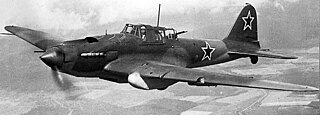 W
WThe Ilyushin Il-2 Shturmovik was a ground-attack aircraft produced by the Soviet Union in large numbers during the Second World War. The Il-2 was never given an official name and 'shturmovik' is the generic Russian word meaning ground attack aircraft. The word also appears in Western sources as Stormovik and Sturmovik, neither of which give correct pronunciation in English.
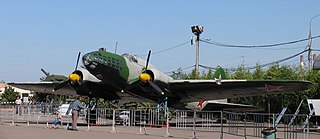 W
WThe Ilyushin Il-4 (DB-3F) was a Soviet twin-engined long-range bomber and torpedo bomber, widely used by the Soviet Air Force and the Soviet Naval Aviation during the World War II.
 W
WThe Ilyushin Il-6 was a Soviet long-range bomber developed from the Ilyushin Il-4 during 1942. Originally intended as a high-speed replacement for the Il-4, it was recast as a very long-range bomber with fuel-conserving diesel engines before production of the single prototype began in December 1942. Flight testing showed controllability issues when landing at high weights and the engines proved to be hard to start at low temperatures and were slow to respond to throttle movements. Further development was canceled in 1944.
 W
WThe Ilyushin Il-10 was a Soviet ground attack aircraft developed at the end of World War II by the Ilyushin construction bureau. It was also license-built in Czechoslovakia by Avia as the Avia B-33.
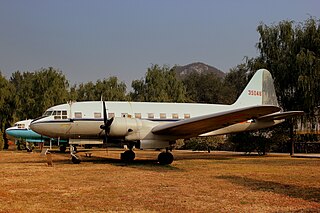 W
WThe Ilyushin Il-12 was a Soviet twin-engine cargo aircraft, developed in the mid-1940s for small and medium-haul airline routes and as a military transport.
 W
WThe Ilyushin Il-14 was a Soviet twin-engine commercial and military personnel and cargo transport aircraft that first flew in 1950, and entered service in 1954. The Il-14 was also manufactured in East Germany by VVB Flugzeugbau as the VEB 14 and in Czechoslovakia as the Avia 14. The Ilyushin Il-14 was typically replaced by the Antonov An-24 and Yakovlev Yak-40.
 W
WThe Ilyushin Il-16 was a Soviet lightweight armored ground-attack aircraft developed at the end of World War II by the Ilyushin Design Bureau. It was in essence a scaled-down version of the Ilyushin Il-10, but was fitted with a newly developed Mikulin AM-43 engine with the expectation that it would be faster and more maneuverable than its predecessor. However, the engine's defects proved to be impossible to rectify and further development was canceled in mid-1946.
 W
WThe Ilyushin Il-18 is a large turboprop airliner that first flew in 1957 and became one of the best known and most durable Soviet aircraft of its era. The Il-18 was one of the world's principal airliners for several decades and was widely exported. Due to the aircraft's airframe durability, many examples achieved over 45,000 flight hours and the type remains operational in both military and civilian capacities. The Il-18's successor was the long range Il-62 jet airliner.
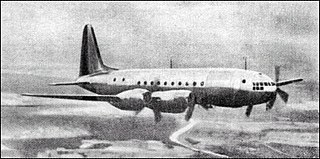 W
WThe Ilyushin Il-18 was a Soviet four-engined airliner designed and built by Ilyushin immediately after World War II. Although the aircraft itself was successful, its Shvetsov ASh-73TK engines were too unreliable for civilian use and were further needed to equip the Tupolev Tu-4 bomber, so it was cancelled in 1948.
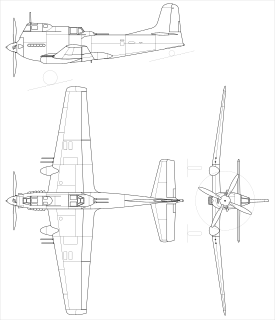 W
WThe Ilyushin Il-20 was a Soviet prototype for a heavily armored ground-attack aircraft to replace the Ilyushin Il-10. It featured a number of innovative concepts including a cockpit mounted on top of the engine, directly behind the propeller, and wing-mounted autocannon that could be adjusted on the ground to fire level or depressed 23° to allow the aircraft to strafe ground targets while remaining in level flight. However it was slower than the Il-10, and its M-47 engine was problematic in flight tests in 1948–49. It was not placed into production. The test pilots called the aircraft the Gorbach (Hunchback).
 W
WThe Ilyushin Il-22, USAF/DOD designation Type 10, was the first Soviet jet-engined bomber to fly. It used four Lyulka TR-1 turbojets carried on short horizontal pylons ahead and below the wing. The engines did not meet their designed thrust ratings and their fuel consumption was higher than planned. These problems meant that the aircraft could not reach its required performance and it was cancelled on 22 September 1947.
 W
WThe Ilyushin Il-28 is a jet bomber of the immediate postwar period that was originally manufactured for the Soviet Air Forces. It was the Soviet Union's first such aircraft to enter large-scale production. It was also licence-built in China as the Harbin H-5. Total production in the USSR was 6,316 aircraft, and over 319 H-5s were built. Only 187 examples of the HJ-5 training variant were manufactured. In the 1990s hundreds remained in service with various air forces over 50 years after the Il-28 first appeared. The only H-5s in service currently are approximately 80 aircraft which operate with the Korean People's Air Force. The Il-28 has the USAF/DoD reporting name "Type 27" and NATO reporting name "Beagle", while the Il-28U trainer variant has the USAF/DoD reporting name "Type 30" and NATO reporting name Mascot.
 W
WThe Ilyushin Il-30 was a Soviet turbojet-powered tactical bomber designed as a higher-performance, swept wing version of the Ilyushin Il-28, in the late 1940s. Its thin wing and engine nacelles necessitated the use of tandem landing gear, the first Soviet aircraft to do so. It was apparently canceled before the prototype made its first flight, although sources disagree with this.
 W
WThe Ilyushin Il-32 was a Soviet heavy military glider developed after World War II to deliver 7,000 kg (15,000 lb) of cargo. To facilitate loading and unloading, the glider's nose and tail sections were hinged to swing sideways. The Il-32 required a four-engined aircraft to tow it safely; it was canceled when it became clear that no such tug was going to be available after the Tupolev Tu-75 and Ilyushin Il-18 programs were both canceled because of shortages of their intended Shvetsov ASh-73 engines.
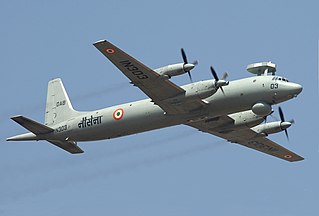 W
WThe Ilyushin Il-38 "Dolphin" is a maritime patrol aircraft and anti-submarine warfare aircraft designed in the Soviet Union. It was a development of the Ilyushin Il-18 turboprop transport.
 W
WThe Ilyushin Il-40 was a two-seat Soviet jet-engined armored ground-attack aircraft. The first prototype flew in 1953 and was very successful except when it fired its guns, as their combustion gasses disturbed the airflow into the engines and caused them to flameout or hiccup. Remedying this problem took over a year and involved the radical change of moving the engine air intakes all the way to the very front of the aircraft and repositioning the guns from the tip of the nose to the bottom of the fuselage, just behind the nosewheel. The aircraft, now resembling a double-barreled shotgun from the front, was ordered into production in 1955. Only five production aircraft had been completed before the entire program was canceled in early 1956 when the VVS discarded its close air-support doctrine in favor of tactical nuclear weapons on the battlefield.
 W
WThe Il-54 was a transonic bomber developed in the USSR in the 1950s. Only two examples were built before the project was abandoned.
 W
WThe Ilyushin Il-62 is a Soviet long-range narrow-body jetliner conceived in 1960 by Ilyushin. As successor to the popular turboprop Il-18 and with capacity for almost 200 passengers and crew, the Il-62 was the world's largest jet airliner when first flown in 1963. One of four pioneering long-range designs, it was the first such type to be operated by the Soviet Union and a number of allied nations.
 W
WThe Ilyushin Il-76 is a multi-purpose four-engine turbofan strategic airlifter designed by the Soviet Union's Ilyushin design bureau. It was first planned as a commercial freighter in 1967, as a replacement for the Antonov An-12. It was designed to deliver heavy machinery to remote, poorly served areas. Military versions of the Il-76 have been widely used in Europe, Asia and Africa, including use as an aerial refueling tanker or command center.
 W
WThe Ilyushin Il-78 is a Soviet four-engined aerial refueling tanker based on the Il-76 strategic airlifter.
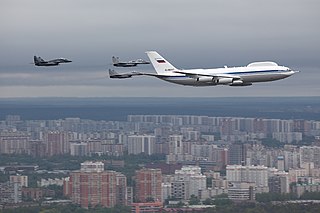 W
WThe Ilyushin Il-80 is a Russian airborne command and control aircraft modified from the Ilyushin Il-86 airliner.
 W
WThe Ilyushin Il-86 is a short- to medium-range wide-body jet airliner that served as the USSR's first wide-bodied aircraft. Designed and tested by the Ilyushin design bureau in the 1970s, it was certified by the Soviet aircraft industry, manufactured and marketed by the USSR.
 W
WThe Ilyushin Il-96 is a Russian quadjet long-haul wide-body airliner designed by Ilyushin in the former Soviet Union and manufactured by the Voronezh Aircraft Production Association in Russia. It is powered by four high-bypass Aviadvigatel PS-90 two-shaft turbofan engines.
 W
WThe Ilyushin Il-102 was a Soviet experimental jet-powered ground-attack aircraft designed by Ilyushin. Once described as the "most gorgeously ugly combat jet ever," this aircraft was never chosen for production, being surpassed by the Su-25. Only a few development prototypes were built.
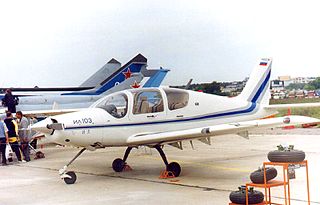 W
WThe Ilyushin Il-103 is a single-engine, low-wing training aircraft developed by the Ilyushin Design Bureau that started in 1990 in the Soviet Union. The aircraft is now produced in Russia. It was the first Russian aircraft to achieve Federal Aviation Administration certification, in 1998, for sales in the United States.
 W
WThe Ilyushin Il-112 is a high-wing light military transport aircraft being developed by Ilyushin Aviation Complex for air landing and airdrop of military air cargoes, equipment and personnel. The aircraft is being manufactured by Voronezh Aircraft Production Association in Voronezh.
 W
WThe Ilyushin Il-114 is a Russian twin-engine turboprop airliner, designed for local routes. Intended to replace the Antonov An-24, it first flew in 1990. A total of 20 Il-114s have been built.
 W
WThe Ilyushin Il-276 (SVTS) is a medium-airlift military transport aircraft currently being developed by initially United Aircraft Corporation (UAC). It is designed to perform regular transport duties and also to deploy up to 150 paratrooper soldiers or up to 20 tons of cargo. According to the Russian press, the Il-276 is expected to begin flight testing in 2023 and deliver the first units in 2026. Ilyushin intends to achieve an annual production rate of 12 units by 2029.